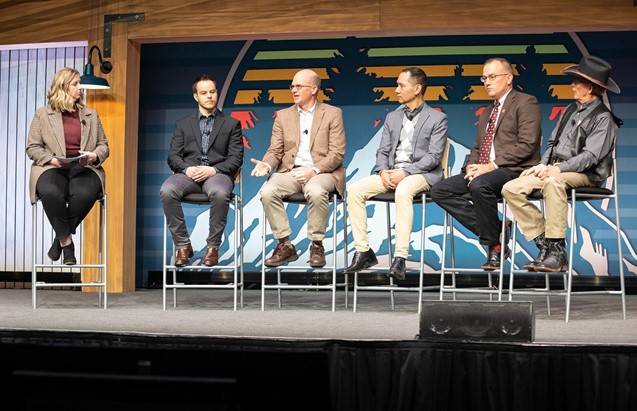
| Panelists discuss the functional longevity EPD and genetic enhancements. |
Take a look into the future and what do you see? For the Angus breed, the future includes leaps into enhanced genomic comprehension and expanded maternal tools for breeders. The 2022 Angus Convention featured a Genetics Symposium, sponsored by NEOGEN, which hosted a panel of industry leaders to discuss the future of genetic data.
Speakers included moderator Kelli Retallick-Riley, Angus Genetics Inc. (AGI®) president, and five panelists – Larry Kuehn, USDA Meat Animal Research Center geneticist; Andre Garcia, AGI geneticist; Gale Haynes, owner of Haynes Cattle Company; Alan Miller, owner of Prairie View Farms and 2021-2022 AGI board chairman; and Duc Lu, AGI geneticist.
For several years, the focus to understand and leverage maternal traits has been a top priority and only continues to become more important. Providing a progress update on the Functional Longevity EPD research for the American Angus Association®, Garcia explained the EPD relies on robust data in mass amounts.
“For those maternal traits it comes down to the data,” Garcia said. “We need to collect those records in order to characterize the genetic variability in the population. To get good spread and accuracy behind those EPDs, we really need to have sires with a lot of daughter records in the population specifically for functional longevity which is lowly heritable.”
As with any EPD, the prediction has little value without accuracy. Lu explained how accuracies shift — when new progeny data is added to an EPD with low accuracy, the accuracy shifts. When new data is added to a high accuracy EPD (accuracy > 0.90), the accuracy isn’t likely to change much because the bull himself is already proven with progeny data. If the animal is already genotyped, this change, or forward movement, can only occur from the collection of more phenotypic data.
“Animals with low accuracies need to have more data because there is not much information estimating that particular animal,” said Lu. “You have to increase the number of phenotypes. You need to collect on that particular animal or its relatives in order to move the accuracy.”
Kuehn added that to increase the spread in EPDs, phenotype and genotype must be used in tandem to create variation in the population.
“We’re actually tying together parts of the family and assumptions about how [animals are] inheriting genetics from those families much better with genomics than what we were ever able to do with pedigree-based genetic evaluation systems alone,” said Kuehn.
Garcia reminded breeders that genetic change cannot occur overnight. He said through careful planning and selection, breeders will see progress.
“Not only is it important to create a breeding objective and have clear goals of where you want to go, but also being disciplined because to make genetic change, it takes generations,” said Garcia. “Creating those goals, being disciplined and following those goals along the way, I think that’s what really is going to move the needle to see the population evolving.”
To aid this forward movement, the Association must continue to add value to the database and tools for the membership. Miller stressed the freedom the Association grants AGI to work with industry partners in order to develop new tools to leverage the competitive advantage.
“We have to make sure we provide that next level of tools so our membership can really be at the forefront of quantifying all sorts of traits and not fall behind any competitors out there,” said Miller.
For news about Angus Convention, visit www.angus.org/Pub/NewsRoomReleaseList.
– Written by Briley Richard, Angus Communications


















